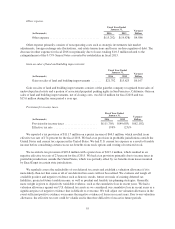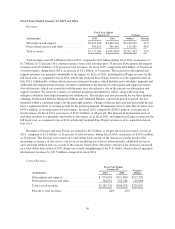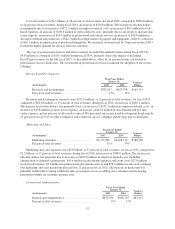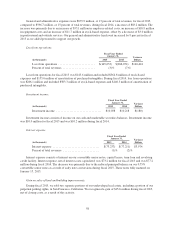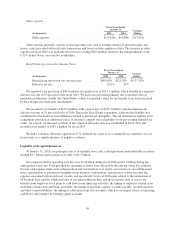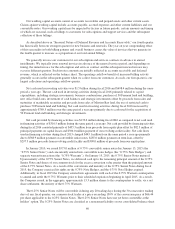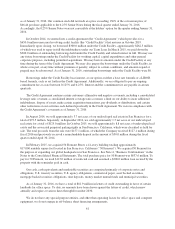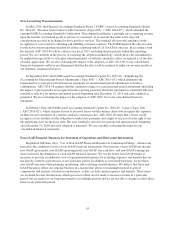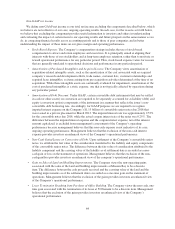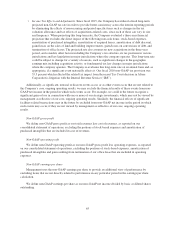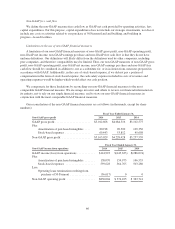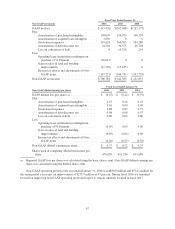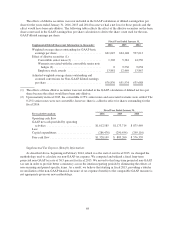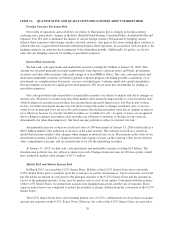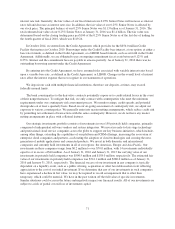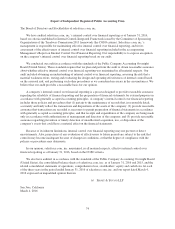Salesforce.com 2016 Annual Report Download - page 71
Download and view the complete annual report
Please find page 71 of the 2016 Salesforce.com annual report below. You can navigate through the pages in the report by either clicking on the pages listed below, or by using the keyword search tool below to find specific information within the annual report.Non-GAAP net income
We define non-GAAP net income as our total net income excluding the components described below, which
we believe are not reflective of our core, ongoing operating results. In each case, for the reasons set forth below,
we believe that excluding the component provides useful information to investors and others in understanding
and evaluating the impact of certain items to our operating results and future prospects in the same manner as we
do, in comparing financial results across accounting periods and to those of peer companies and in better
understanding the impact of these items on our gross margin and operating performance.
•Stock-Based Expense. The Company’s compensation strategy includes the use of stock-based
compensation to attract and retain employees and executives. It is principally aimed at aligning their
interests with those of our stockholders and at long-term employee retention, rather than to motivate or
reward operational performance for any particular period. Thus, stock-based expense varies for reasons
that are generally unrelated to operational decisions and performance in any particular period.
•Amortization of Purchased Intangibles and Acquired Leases. The Company views amortization of
acquisition-related intangible assets, such as the amortization of the cost associated with an acquired
company’s research and development efforts, trade names, customer lists, customer relationships and
acquired lease intangibles, as items arising from pre-acquisition activities determined at the time of an
acquisition. While these intangible assets are continually evaluated for impairment, amortization of the
cost of purchased intangibles is a static expense, one that is not typically affected by operations during
any particular period.
•Amortization of Debt Discount. Under GAAP, certain convertible debt instruments that may be settled
in cash (or other assets) on conversion are required to be separately accounted for as liability (debt) and
equity (conversion option) components of the instrument in a manner that reflects the issuer’s non-
convertible debt borrowing rate. Accordingly, for GAAP purposes we are required to recognize
imputed interest expense on the Company’s $1.15 billion of convertible senior notes due 2018 that
were issued in a private placement in March 2013. The imputed interest rate was approximately 2.53%
for the convertible notes due 2018, while the actual coupon interest rate of the notes was 0.25%. The
difference between the imputed interest expense and the coupon interest expense, net of the interest
amount capitalized, is excluded from management’s assessment of the Company’s operating
performance because management believes that this non-cash expense is not indicative of its core,
ongoing operating performance. Management believes that the exclusion of the non-cash interest
expense provides investors an enhanced view of the Company’s operational performance.
•Non-Cash Gains/Losses on Conversion of Debt. Upon settlement of the Company’s convertible senior
notes, we attribute the fair value of the consideration transferred to the liability and equity components
of the convertible senior notes. The difference between the fair value of consideration attributed to the
liability component and the carrying value of the liability as of settlement date is recorded as a non-
cash gain or loss on the statement of operations. Management believes that the exclusion of the non-
cash gain/loss provides investors an enhanced view of the company’s operational performance.
•Gain on Sales of Land and Building Improvements. The Company views the non-operating gains
associated with the sales of the land and building improvements at Mission Bay to be a discrete
item. The difference between the cash proceeds received and the carrying value of the land and the
building improvements as of the settlement date is recorded as a one-time gain on the statement of
operations. Management believes that the exclusion of the gains provides investors an enhanced view
of the Company’s operational performance.
•Lease Termination Resulting from Purchase of Office Building. The Company views the non-cash, one-
time gain associated with the termination of its lease at 50 Fremont to be a discrete item. Management
believes that the exclusion of the gains provides investors an enhanced view of the Company’s
operational performance.
64



